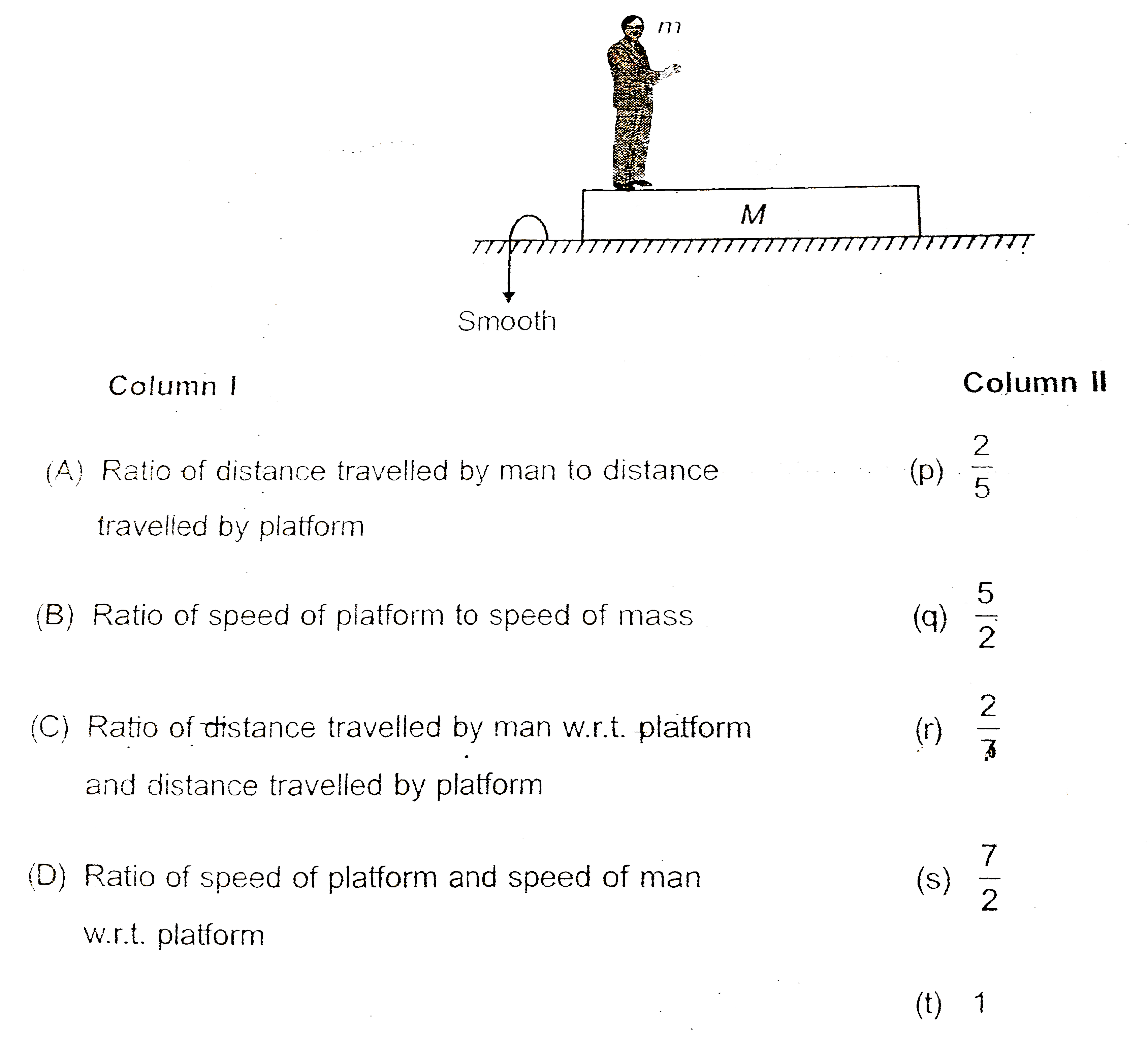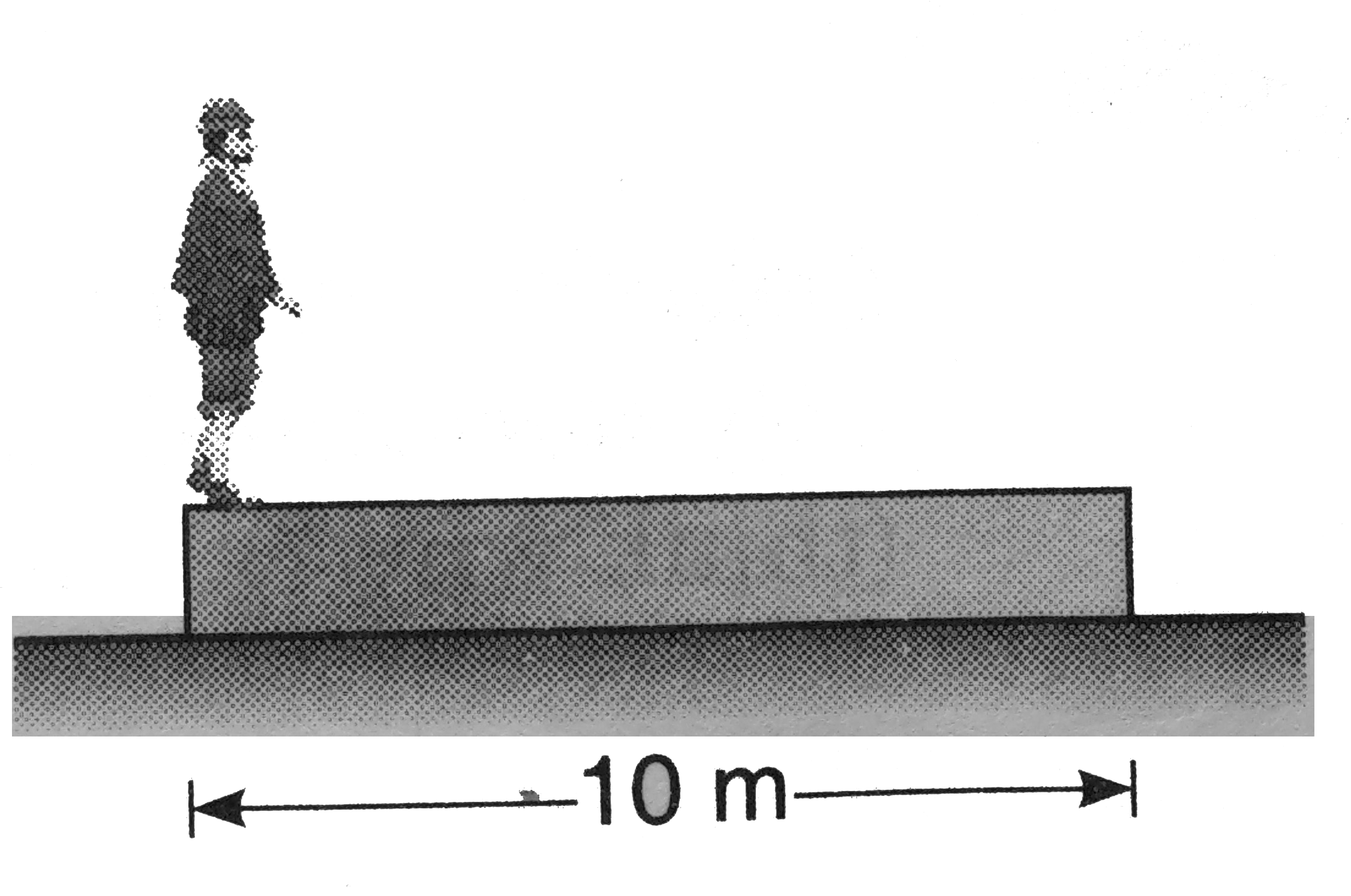A man of 50kg mass is standing in a gravity free space at a height of 10m above the floor. He throws a stone of 0.5kg mass downwards with a speed 2m/s. When the stone reaches the floor, the distance of the man above the floor will be
9.9m
10.1m
1.0m
20m
The correct Answer is:B
To solve the problem, we need to analyze the situation step by step.
Step 1: Understand the scenario
A man with a mass of 50 kg is standing at a height of 10 meters above the floor in a gravity-free space. He throws a stone of mass 0.5 kg downwards with an initial speed of 2 m/s.
Step 2: Determine the time taken for the stone to reach the floor
Since the man is in gravity-free space, we can assume that there is no gravitational force acting on the stone after it is thrown. The stone will continue to move downwards with the initial velocity it was thrown with.
The distance the stone needs to cover to reach the floor is 10 meters. The stone is thrown downwards with an initial speed of 2 m/s.
Using the formula for distance:
Distance=Initial Velocity×Time
We can rearrange this to find time:
Time=DistanceInitial Velocity
Substituting the values:
Time=10m2m/s=5s
Step 3: Determine the distance the man moves during this time
In gravity-free space, the man will not move upwards or downwards due to the absence of any gravitational force acting on him. Therefore, he will remain at the same height above the floor.
Step 4: Calculate the man's height above the floor when the stone reaches the floor
Since the man does not move, he will still be at the height of 10 meters above the floor when the stone reaches the floor.
Final Answer
The distance of the man above the floor when the stone reaches the floor will be 10 meters.
---
A man with a mass of 50 kg is standing at a height of 10 meters above the floor in a gravity-free space. He throws a stone of mass 0.5 kg downwards with an initial speed of 2 m/s.
Since the man is in gravity-free space, we can assume that there is no gravitational force acting on the stone after it is thrown. The stone will continue to move downwards with the initial velocity it was thrown with.
Distance=Initial Velocity×Time
We can rearrange this to find time:
Time=DistanceInitial Velocity
Substituting the values:
Time=10m2m/s=5s
In gravity-free space, the man will not move upwards or downwards due to the absence of any gravitational force acting on him. Therefore, he will remain at the same height above the floor.
Since the man does not move, he will still be at the height of 10 meters above the floor when the stone reaches the floor.
The distance of the man above the floor when the stone reaches the floor will be 10 meters.
Topper's Solved these Questions
- WORK, ENERGY AND POWERBook:PRADEEPChapter:WORK, ENERGY AND POWERExercise:Comprehension
Explore 9 Videos
- WORK, ENERGY AND POWERBook:PRADEEPChapter:WORK, ENERGY AND POWERExercise:Integer Type Questions
Explore 9 Videos
- WORK, ENERGY AND POWERBook:PRADEEPChapter:WORK, ENERGY AND POWERExercise:NCERT( Multiple choide questions-1)
Explore 21 Videos
- THERMODYNAMICSBook:PRADEEPChapter:THERMODYNAMICSExercise:Assertion- Reason Type Questions
Explore 19 Videos
Similar Questions
A man of mass m=2kg is standing on a platform of mass M=5kg, then at any instant.

View SolutionA boy of mass 60kg is standing over a platform of mass 40kg placed over a smooth horizontal surface. He throws a stone of mass 1kg with velocity v=10m/s at an angle of 45∘ with respect to the ground. Find the displacement of the platform (with boy) on the horizontal surface when the stone lands on the ground. Take g=10m/s2.
View Solution
Knowledge Check
In a gravity free space, man of mass M standing at a height h above the floor, throws a ball of mass m straight down with a speed u. When the ball reaches the floor, the distance of the man above the floor will be.
Ah(1+m/M)Bh(2−m/M)C2 hDa function of m,handu.Which of the following statements are true ?
(i) A uniform wooden plank of mass 150kg and length 8m is floating on still water with a man of 50kg at one end of it. The man walks to the other end of the plank and stops. The distance covered by the plank is 2m.
(ii) A kid of mass 15kg is sitting in a boat of mass 45kg in a lake. The distance of kid from the bank of lake is 12m. Now the body moves inside the boat at a distance 4m towards the bank and stops. The distance of the kid from the bank (there is no friction between the water and the boat ) is 11m.
(iii) Two persons of masses 40kg and 60kg are sitting at the midpoint of a 12−m- long boat (140kg) standing still in water. Now they move to opposite ends of the boat. Neglecting the friction between boat and water, the distance traveled by the boat in water is 50cm.
(iv) In a gravity free space , a man of mass m standing at a height h above the floor, throws a ball of mass m0 straight down with a speed v0. When the ball reaches the floor, the distance of the man above the floor is (1+m0m)h.A(i),(ii)B(i) ,(iii) ,(iv)C(ii),(iii),(iv)Dall of the aboveA man of mass 60 kg is standing on a boat of mass 140 kg, which is at rest in still water. The man is initially at 20 m from the shore. He starts walking on the boat for 4 s with constant speed 1.5 m/s towards the shore. The final distance of the man from the shore is
A15.8 mB4.2 mC12.6 mD14.1 m
what is the momentum of a man of mass 75kg when he walks with a velocity of 2m/s?
View SolutionA wooden plank of mass 20kg is resting on a smooth horizontal floor. A man of mass 60kg starts moving from one end of the plank to the other end. The length of the plank is 10m. Find the displacement of the plank over the floor when the man reaches the other end of the plank.

View SolutionA young man of mass 60 kg stands on the floor of a lift which is accelerating downwards at 1m/s2 then the reaction of the floor of the lift on the man is (Take g=9.8m/s2).
View SolutionA young man of mass 60kg stands on the floor of a lift which is acceleration downwards at 1m/s2 then the reaction of the floor of the lift on the man is (Take g=9.8m/s2)
View SolutionA man of mass 90 kg is standing in a lift whose cable broke suddenly. If thelift falls freely, the force exerted by the floor on the man is
View Solution
